|
|
|
Sort Order |
|
|
|
Items / Page
|
|
|
|
|
|
|
| Srl | Item |
| 1 |
ID:
163303
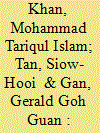

|
|
|
|
|
| Summary/Abstract |
This article presents the advanced financial literacy of Malaysian Gen Y investors and investigates whether literacy varies across demographics and ethnicity, and how financial literacy is related to investing decisions. In a survey-based study (N = 231) with the estimation of crosstab, ordered logistic regression and binary logistic regression, the results suggest that Gen Y investors display a medium level of financial literacy and that investors with certain demographic characteristics and ethnicity display a relatively higher level of financial literacy. Literacy items such as knowledge of stocks and bonds, functioning of the stock market, working of long-term bonds and mutual funds, and riskiness of bonds versus stocks are more closely related to investors’ trading, risky share investment, willingness of risk-taking, stock market participation and perceived portfolio returns. The results imply a clear scope to improve Gen Y investors’ financial literacy by concentrating on a certain socio-demographic groups and specific financial literacy items.
|
|
|
|
|
|
|
|
|
|
|
|
|
|
|
|
| 2 |
ID:
155116
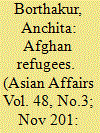

|
|
|
|
|
| Summary/Abstract |
One of the most important arenas that have been profoundly affected by the security situation in Afghanistan is Pakistan's internal security environment. The instability in Afghanistan has had a negative spill-over effect on Pakistan's domestic security scenario, as the Afghan quagmire poses immense implications on Pakistan's domestic framework. One of the important consequences of the Afghan conflict since the 1970s has been the massive inflow of the Afghan refugee population to the neighbouring Pakistan which in following years has brought about a number of demographic and security challenges to the Pakistani society. Therefore along with a number of factors, at this present juncture, Afghan refugees have also become a principal factor in determining Pakistan's Afghanistan policy.
|
|
|
|
|
|
|
|
|
|
|
|
|
|
|
|
| 3 |
ID:
112960


|
|
|
|
|
| Publication |
2012.
|
| Summary/Abstract |
By virtue of its very small local population and its extremely high level of oil and gas resources, Qatar simply does not face the socio-economic or political pressures coursing through the region. Uniquely, it has embraced the Arab uprisings as an opportunity, rather than a challenge, to cement its international (Western) reputation, albeit at the expense of some of its regional relationships.
|
|
|
|
|
|
|
|
|
|
|
|
|
|
|
|
| 4 |
ID:
116540


|
|
|
|
|
| Publication |
2012.
|
| Summary/Abstract |
The aim of this article is on the one hand, to draw up a socio-demographic inventory of the situation of Chinese women in the prevailing early twenty-first century context of demographic, economic, and social transition, and on the other hand, to draw attention to the paradoxical effects of these transitions whilst taking into account the diversity of the realities women are experiencing. In conclusion, it raises the possibility of changes in gender relationships in China, where there are, and will continue to be, fewer women than men, particularly in adulthood.
|
|
|
|
|
|
|
|
|
|
|
|
|
|
|
|
| 5 |
ID:
132912
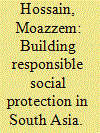

|
|
|
|
|
| Publication |
2014.
|
| Summary/Abstract |
inspired by the global ambition to eradicate poverty through the Millennium Development Goals, to be achieved by 2015, this article finds that continuing population growth in South Asia will make such goals impossible to achieve. Rather than sinking into despair, however, the article first captures specifically the major demographic reasons behind the troubling bottlenecks of development in South Asia. Since tackling those demographic issues will not yield tangible results in the short run, the focus of analysis then switches to arguing that other creative development remedies are indeed feasible. Given that there is no scarcity of food in South Asia, but it simply does not reach those who need it most, the article demonstrates that India's recent Food Security Act of 2013 may be a globally relevant model of concerted state action to tackle deep poverty and avoid mass starvation. This article breaks new ground in relation to implementing state-led social welfare measures, showing that earlier assessments about Asian development may have been too pessimistic.
|
|
|
|
|
|
|
|
|
|
|
|
|
|
|
|
| 6 |
ID:
180052
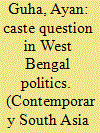

|
|
|
|
|
| Summary/Abstract |
The electoral decline of the organised Left in West Bengal politics has given rise to intellectual speculation about the increasing possibility of caste politics. In this context, this article investigates whether there is any merit in the claim that the electoral decline of the Left Front has paved the way for the rise of caste at the centre stage of mainstream electoral politics in West Bengal. It asks whether lower castes have started to mobilise politically in West Bengal in the same way as in many other states. The article argues against the claim of ‘a new politics of caste’ in West Bengal by showing that the electoral decline of the Left Front has not been accompanied by any rise in lower caste representation. In this context, the article also attempts to understand the reasons for the continuing non-politicisation of caste in West Bengal, revealing many factors relating to demography and political economy which don’t augur well for caste politics in West Bengal.
|
|
|
|
|
|
|
|
|
|
|
|
|
|
|
|
| 7 |
ID:
122655
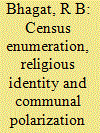

|
|
|
|
|
| Publication |
2013.
|
| Summary/Abstract |
Census is considered to be a scientific exercise. However, it leaves a deep impact on religious and ethnic identities. This is because through census enumeration not only are boundaries of communities fixed, but also actual size and growth are known. This adds a new sense to the identities of the religious communities in the sphere of democratic politics. In India, the census was started around 1872 during the British rule, seven decades after the first census was held in Great Britain in 1801. The question on religion was included right from the first Indian census, unlike the British census which only included it in 2001. This paper shows that the inclusion of the question on religion, and the consequent publication of data on size and growth of population by religion during British rule, invoked sharp communal reactions. The demographic issues found a core place in the communal discourse that continued in independent India. The paper argues that the demographic data on religion was one of the important factors that raised Hindu-Muslim consciousness and shaped the Hindu and Muslim relationship in both colonial and postcolonial India. As a result, several demographic myths have found a place in the communal discourse shaping the political imagination of India.
|
|
|
|
|
|
|
|
|
|
|
|
|
|
|
|
| 8 |
ID:
024930
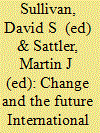

|
|
|
|
|
| Publication |
New York, Columbia University Press, 1971.
|
| Description |
ix, 109p.
|
| Standard Number |
0231083041
|
|
|
|
|
|
|
|
|
|
|
|
Copies: C:1/I:0,R:0,Q:0
Circulation
| Accession# | Call# | Current Location | Status | Policy | Location |
| 018004 | 327/SUL 018004 | Main | On Shelf | General | |
|
|
|
|
| 9 |
ID:
119158
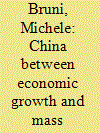

|
|
|
|
|
| Publication |
2013.
|
| Summary/Abstract |
In order to continue along its path of sustained economic growth, China will need, probably in just a few years, certainly after 2030, an extremely high number of immigrants. This conclusion, which contrasts with a recent World Bank scenario suggesting that the decline in labor supply due to demographic trends can be faced with sustained growth in productivity, is based upon a demand-driven model of migration. Moreover, according to the same model, the decline in fertility (and the one child policy that has been partially responsible for it) will end up provoking immigration flows above replacement level. The working age population and the total population will continue to increase, and China will remain the most populous country on the planet. The last part of the paper surveys the policies that China could adopt to reduce its structural need for foreign labor.
|
|
|
|
|
|
|
|
|
|
|
|
|
|
|
|
| 10 |
ID:
090934
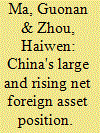

|
|
|
|
|
| Publication |
2009.
|
| Summary/Abstract |
China's emergence as a major player in world trade is well known, but its growing role in global finance might have been underappreciated. China is the second largest creditor in the world today, with a net creditor position of 30 percent of GDP in 2008. We test the importance of the growth differential, demographics, government debt, financial depth and the exchange rate in shaping China's net foreign asset position. Our empirical results highlight the sharp fall in the young-age dependence as one key driver behind China's puzzlingly large net lender position and also confirm the neoclassical prediction that faster growth attracts more capital inflows. Looking ahead, our findings suggest that China will unlikely turn into a meaningful net debtor nation over the next two decades.
|
|
|
|
|
|
|
|
|
|
|
|
|
|
|
|
| 11 |
ID:
152489
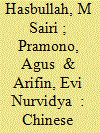

|
|
|
|
|
| Summary/Abstract |
This paper provides new statistics to the debate on percentage of Chinese Indonesians, using the latest 100% data set of the 2010 population census. It reveals that the statistics is closer to the low side of the debate, less than 2.0%, rather than the high side of 3.0% and more. Ethnicity is here self-defined by the respondents. With 1.2%, the Chinese Indonesians ranked as the 15th largest group of more than 600 ethnic groups. This paper also produces statistics at the district level, the first ever statistics on Chinese Indonesians. It finds that some provinces and districts have large percentages of Chinese Indonesians, but the respective total population are relatively small to the total Indonesia’s population. Majority of provinces and districts (25 out of 33 provinces and 415 out of 497 districts) have lower percentage of Chinese than the national figure.
|
|
|
|
|
|
|
|
|
|
|
|
|
|
|
|
| 12 |
ID:
101673
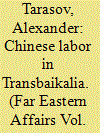

|
|
|
|
|
| Publication |
2010.
|
| Summary/Abstract |
The unfavorable demographic situation in the region calls for an influx of labor migrants, which is an important factor of economic life. The drawing of foreign labor force contributes to the development of the local economy. Meanwhile, the presence of Chinese migrants in the region is insignificant so far, does not pose a threat to employment of the local people, and is not the cause of social problems.
|
|
|
|
|
|
|
|
|
|
|
|
|
|
|
|
| 13 |
ID:
001638
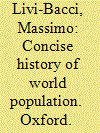

|
|
|
|
|
| Publication |
Oxford, Blackwell, 1997.
|
| Description |
xx, 250p.
|
| Standard Number |
0-631-20454-7
|
|
|
|
|
|
|
|
|
|
|
|
Copies: C:1/I:0,R:0,Q:0
Circulation
| Accession# | Call# | Current Location | Status | Policy | Location |
| 041253 | 304.6/LIV 041253 | Main | On Shelf | General | |
|
|
|
|
| 14 |
ID:
006370
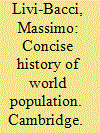

|
|
|
|
|
| Publication |
Cambridge, Blackwell, 1992.
|
| Description |
xvi, 220p., figures and tables
|
| Standard Number |
1-557896-269-9
|
|
|
|
|
|
|
|
|
|
|
|
Copies: C:1/I:0,R:0,Q:0
Circulation
| Accession# | Call# | Current Location | Status | Policy | Location |
| 038043 | 304.6/LIV 038043 | Main | On Shelf | General | |
|
|
|
|
| 15 |
ID:
108754


|
|
|
|
|
| Publication |
New York, Columbia University Press, 2007.
|
| Description |
xv, 134p.
|
| Standard Number |
9780231527460, hbk
|
|
|
|
|
|
|
|
|
|
|
|
Copies: C:1/I:0,R:0,Q:0
Circulation
| Accession# | Call# | Current Location | Status | Policy | Location |
| 056354 | 304.6091767/COU 056354 | Main | On Shelf | General | |
|
|
|
|
| 16 |
ID:
173750


|
|
|
|
|
| Summary/Abstract |
From an obscure sector synonymous with mercenaryism, the private military and security industry has grown to become a significant complementing instrument in military operations. This rise has brought with it a considerable attention. Researchers have examined the role of private military and security companies in international relations as well as the history of these companies, and, above all, the legal implications of their use in the place of military organizations. As research progresses, a significant gap has become clear. Only a handful of studies have addressed the complex of issues associated with contractors’ demographics and lived experience. This article sheds some light over this lacuna, examining contractors’ demographics using descriptive statistics from an original data set of American and British contractors who died in Iraq between the years 2003 and 2016. The article augments our understanding of an important population of post-Fordist-contracted workforce, those peripheral workers supplementing military activity in high-risk occupations with uncertain long-term outcomes.
|
|
|
|
|
|
|
|
|
|
|
|
|
|
|
|
| 17 |
ID:
013109
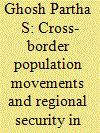

|
|
|
|
|
| Publication |
Oct 1997.
|
| Description |
1-23
|
|
|
|
|
|
|
|
|
|
|
|
|
|
|
|
| 18 |
ID:
037905
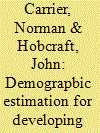

|
|
|
|
|
| Publication |
London, Population Investigation Committee, 1971.
|
| Description |
204p
|
|
|
|
|
|
|
|
|
|
|
|
Copies: C:1/I:0,R:0,Q:0
Circulation
| Accession# | Call# | Current Location | Status | Policy | Location |
| 008897 | 304.6021091724/CAR 008897 | Main | On Shelf | General | |
|
|
|
|
| 19 |
ID:
119635


|
|
|
|
|
| Publication |
2013.
|
| Summary/Abstract |
Research on conflict traditionally focuses on its initiation, duration, and severity, but seldom on its consequences. Yet, demographic and economic recovery from the consequences of war lasts far longer and may be more devastating than the waging war. Our concern is with war losses and post-war recovery leading to convergence with pre-war performance. To test this proposition, we choose the most severe international and civil wars after 1920. We find that all belligerents recover or overtake demographic losses incurred in war. Economic assessments differ. The most-developed belligerents recover like a "phoenix" from immense destruction in one generation. For less-developed societies, the outcomes are mixed. The less-developed belligerents recover only a portion of their pre-war performance. The least-developed societies suffer the most and fall into lasting poverty traps. The overlapping generation growth model accounts for such differences in recovery rates based on pre-war performance challenging arguments from Solow's neoclassical growth perspective. Our results imply that foreign aid is incidental to the post-war convergence for the most-developed societies, can prompt recovery for the less-developed societies, and is not effective-unless it is massive and sustained-for the least-developed societies. World War II may provide a poor guide to current post-war challenges in Iraq and in Afghanistan.
|
|
|
|
|
|
|
|
|
|
|
|
|
|
|
|
| 20 |
ID:
130391
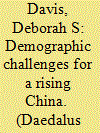

|
|
|
|
|
| Publication |
2014.
|
| Summary/Abstract |
Looking into the near future, China faces immense demographic challenges. Prolonged sub-replacement fertility has created irreversible conditions for rapid aging of the population, and massive migration to cities has left many villages populated by elderly farmers with no adult children to support them. Soaring divorce rates and high levels of residential dislocation have eroded family stability. To a large extent, government policies created to accelerate economic growth inadvertently fostered these demographic challenges, and now the country is facing the negative consequences of interventions that previously spurred double-digit growth. Legacies of Confucian familism initially blunted pressures on families. Filial sons and daughters sent back remittances, parents cared for migrants' children and invested in their children's marriages, and families with four grandparents, two parents, and one child (4+2+1) pooled resources to continuously improve a family's material well-being. But now the demographic challenges have further intensified and the question arises: can the state adopt new policies that will allow the prototypical 4+2+1 families created by the one-child policy to thrive through 2030?
|
|
|
|
|
|
|
|
|
|
|
|
|
|
|
|
|
|
|
|
|